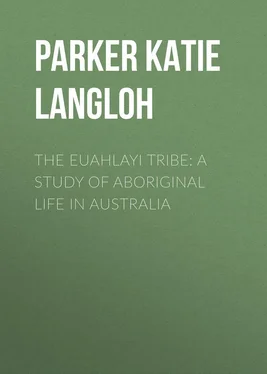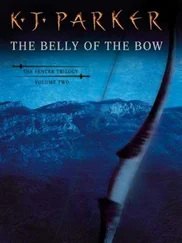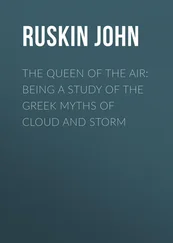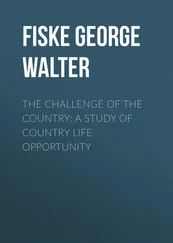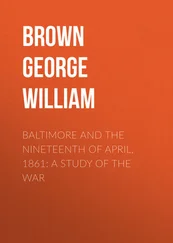The origin of this division is said to be the fact that the original ancestors were, on the one side, a red race coming from the west, the Gwaigulleeah; on the other, a dark race coming from the east.
A Gwaigulleeah may under no circumstances marry a Gwaigulleeah; he or she must mate with a Gwaimudthen. This rule has no exception. A child belongs to the same phratry as its mother.
The next name of connection is local, based on belonging to one country or hunting-ground; this name a child takes from its mother wherever it may happen to be born. Any one who is called a Noongahburrah belongs to the Noongah-Kurrajong country; Ghurreeburrah to the orchid country; Mirriehburrah, poligonum country; Bibbilah, Bibbil country, and so on. This division, not of blood relationship, carries no independent marriage restriction, but keeps up a feeling equivalent to Scotch, Irish, or English, and is counted by the blacks as 'relationship,' but not sufficiently so to bar marriage.
The next division is the name in common for all daughters, or all sons of one family of sisters. The daughters take the name from their maternal grandmother, the sons from their maternal great-uncle.
Of these divisions, called I Matrimonial Classes, there are four for each sex, bearing the same names as among the Kamilaroi. The names are —
Masculine Kumbo BROTHER AND SISTER
Feminine, Bootha
Masculine Murree BROTHER AND SISTER
Feminine, Matha
Masculine Hippi BROTHER AND SISTER
Feminine, Hippitha
Masculine Kubbee BROTHER AND SISTER
Feminine, Kubbootha
The children of Bootha will be
Masculine Hippi BROTHER AND SISTER
Feminine, Hippitha
The children of Matha will be
Masculine Kubbee BROTHER AND SISTER
Feminine, Kubbootha
The children of Hippatha will be
Masculine Kumbo BROTHER AND SISTER
Feminine, Bootha
The children of Kubbootha will be
Masculine Murree BROTHER AND SISTER
Feminine, Matha
Thus, you see, they take, if girls, their grandmother's and her sisters' 'class' names in common; if boys, the 'class' name of their grandmother's brothers.
Bootha can only marry Murree,
Matha can only marry Kumbo,
Hippitha can only marry Kubbee,
Kubbootha can only marry Hippi.
Both men and women are often addressed by these names when spoken to.
A PROPOS of names, a child is never called at night by the same name as in the daytime, lest the 'devils' hear it and entice him away.
Names are made for the newly born according to circumstances; a girl born under a Dheal tree, for example, was called Dheala. Any incident happening at the time of birth may gain a child a name, such as a particular lizard passing. Two of my black maids were called after lizards in that way: Barahgurree and Bogginbinnia.
Nimmaylee is a porcupine with the spines coming; such an one having been brought to the camp just as a girl was born, she became Nimmaylee.
The mothers, with native politeness, ask you to give their children English names, but much mote often use in familiar conversation either the Kumbo Bootha names, or others derived from place of birth, from some circumstance connected with it, a child's mispronunciation of a word, some peculiarity noticed in the child, or still more often they call each other by the name proclaiming the degree of relationship.
For example, a girl calls the daughters of her mother and of her aunts alike sisters.
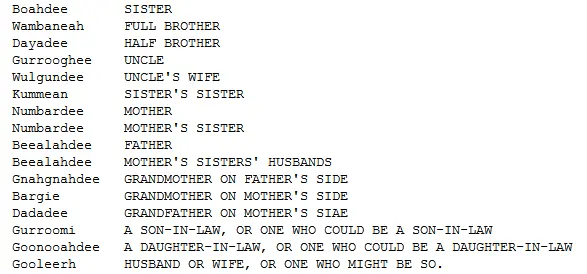
So relationships are always kept in their memories by being daily used as names. There are other general names, too, such as —

Another list of names used ordinarily is —

Those of the same totem are reckoned as brothers and sisters, so cannot intermarry. 'Boyjerh' relations, as those on the father's side are called, are not so important as on the mother's side, but are still recognised.
Now for the great Dhe, or totem system, by some called Mah, but Dhe, is the more correct.
Dinewan, or emu, is a totem, and has amongst its multiplex totems' or 'sub-totems' —

Bohrah, the kangaroo, is another totem, and is considered somewhat akin to Dinewan. For example, in a quarrel between, say, the Bohrah totem and the Beewee, the Dinewan would take the part of the former rather than the latter.
Amongst the multiplex totems of Bohrah are —
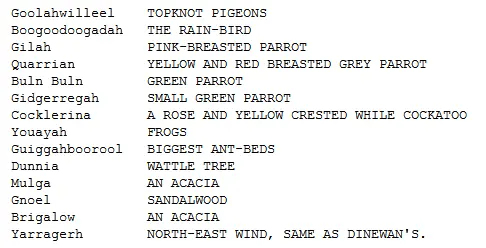
All clouds, lightning, thunder, and rain that is not blown up by the wind of another totem, belong to Bohrah.
Beewee, brown and yellow Iguana, numerically a very powerful totem, has for multiplex totems —
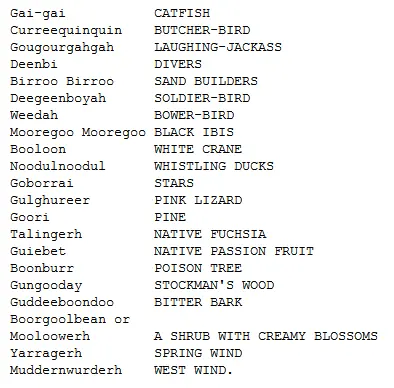
Those with whom the Beewee shares the winds he counts as relations. It is the Beewees of the Gwaimudthen, or dark blood, who own Yarragerh (spring wind); the light-blooded own Mudderwurderh (west wind).
Another totem is Gouyou, or Bandicoot. The animal has disappeared from the Narran district, but the totem tribe is still strong, though not so numerous as either the Beewees or Dinewans.
Multiplex totems of Gouyou —

Next we take Doolungaiyah, or Bilber, commonly known as Bilby, a large species of rat the size of a small rabbit, like which it burrows; almost died out now. The totem clan are very few here too, so it is difficult to learn much as to their multiplex totems, amongst which, however, are —

Douyou, black snake, totem claims —
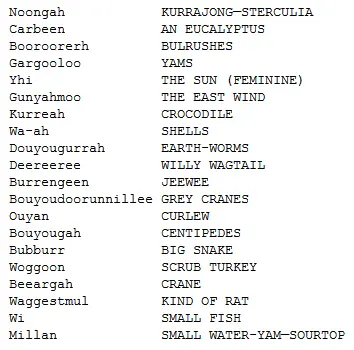
Moodai, or opossum, another totem, claims —
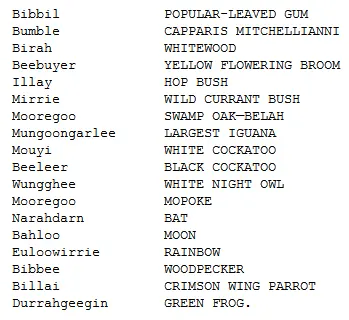
Maira, a paddy melon, claims as multiplex totems —
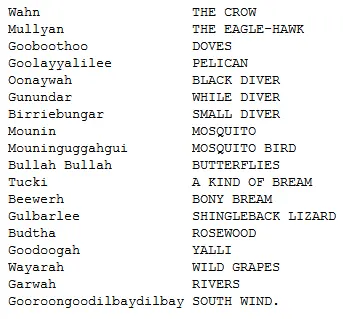
It is said a Maira will never be drowned, for the rivers are a sub-totem of theirs; but I notice they nevertheless learn to swim.
Yubbah, carpet snake, as a kin has almost disappeared, only a few members remaining to claim

Burrahwahn, a big sandhill rat, now extinct here, claims —
Читать дальше
